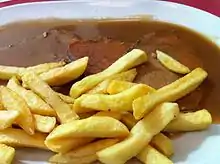Espagnole sauce
Espagnole sauce (French pronunciation: [ɛspaɲɔl]) is a basic brown sauce, and is one of Auguste Escoffier's five mother sauces of classic French cooking. Escoffier popularized the recipe, which is still followed today.[1]

Espagnole has a strong taste, and is rarely used directly on food. As a mother sauce, it serves as the starting point for many derivatives, such as sauce africaine, sauce bigarade, sauce bourguignonne, sauce aux champignons, sauce charcutière, sauce chasseur, sauce chevreuil, and demi-glace. Hundreds of other derivatives are in the classical French repertoire.
Escoffier included a recipe for a Lenten espagnole sauce, using fish stock and mushrooms, in Le Guide culinaire, but doubted its necessity.
Preparation
The basic method of making espagnole is to prepare a very dark brown roux, to which brown stock (stock made from simmering roasted bones, meats and aromatics[2]) is added, along with roasted bones, pieces of beef, vegetables, brown sugar and various seasonings. This blend is allowed to slowly reduce while being frequently skimmed. The classic recipe calls for additional veal stock to be added as the liquid gradually reduces, but today, water is generally used instead. Tomato paste or pureed tomatoes are added towards the end of the process, and the sauce is further reduced.[1]
Another version can be made with white stock and butter by adding onion, ham, red pepper, celery, cayenne pepper and parsley, with flour as thickener.[3]
Etymology
Espagnole is the French word for "Spanish", but the sauce's origin story is argued by French cooks. According to Louis Diat, the creator of vichyssoise and the author of the classic Gourmet's Basic French Cookbook:
"There is a story that explains why the most important basic brown sauce in French cuisine is called sauce espagnole, or Spanish sauce. According to the story, the Spanish cooks of Louis XIII's bride, Anne, helped to prepare their wedding feast, and insisted upon improving the rich brown sauce of France with Spanish tomatoes. This new sauce was an instant success, and was gratefully named in honor of its creators."[4]
In Kettner's Book of the Table, published in 1877, an entirely different explanation is given:
When the Bourbons made their way to the Spanish throne under Louis XV, and when Spanish fashions came back to Paris, the French cooks took a hint from the Spanish pot-au-feu—the olla podrida—and produced a variation of their brown sauce which they called "Spanish". The essential principle of the French pot-au-feu was beef; the essential principle of the Spanish was bacon, ham, the red Estremadura sausage—all well smoked ... The Duc de St. Simon sent home marvellous accounts of the hams of Montanches; there grew up a rage for Spanish hams; and the French were not to blame, for they have no hams of their own which have any reputation. Great as they are in pig's flesh, they are poor hands at bacon and ham; and the treasures of Montanches were a revelation to them. They ran wild after ham ... And so, by introducing the flavour of the Estremadura bacon and ham into the old brown sauce of the French, there came into being the Spanish sauce ... The hams of Montanches are not too plentiful in this world of sorrow, and the cooks came to be satisfied with any ham—even with French ham, which is little better than salted pork. So the meaning of the prescription was lost; the peculiarity of the Spanish sauce passed away, and its name became a puzzle.[5]
The name "Kettner" in the title refers to Auguste Kettner, former chef to Napoleon III, who emigrated to England and in 1867 opened a restaurant in Soho, Kettner's, one of the oldest restaurants in London.
See also
References
- Escoffier (1903), Le Guide culinaire, Editions Flammarion
- reluctantgourmet (2012-09-14). "How to Make Brown Stock". The Reluctant Gourmet. Retrieved 2020-10-16.
- Lowney's Cook Book (1912) p121
- Waters, Mrs. W.G. (1920). The Cook's Decameron: A Study In Taste. IndyPublish.com. ISBN 1-4043-4580-9.
- E.S.Dallas (1877), Kettner's Book of the Table, Dullau and Co., London, digitized by Google, retrieved 2008
External links
| Wikibooks Cookbook has a recipe/module on |